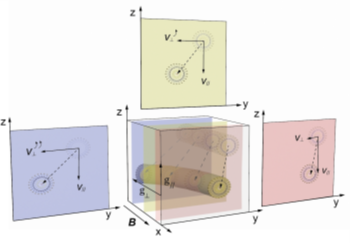Magnetic skyrmions are nanoscale knots of twisting spins that hold promise for next-generation data storage and processing technologies due to their stability and sensitivity to external stimuli. Traditionally, research focus in this area has been on manipulating the positions of skyrmions in the two-dimensional plane in which they sit. However, this study, published in Nature Communications, shifts the paradigm by showing that skyrmion strings, which extend in three dimensions, can be bent and controlled by a varying temperature gradient.

The research team used small angle neutron scattering (SANS) on Larmor to observe this phenomenon in the chiral magnet MnSi by applying thermal gradients perpendicular to the skyrmion string. As the temperature changes along the length of the string, the magnon friction and skyrmion Hall effect, which act as effective forces on the skyrmion, cause the string to bend. This novel manipulation technique provides a way to control these structures in another dimension. The figure, right, shows an illustration of the skyrmion string bending mechanism in a 2D thermal gradient. Each of the different coloured yz-slices experience different temperatures, leading to different magnon frictions and the bending of the skyrmion string.
“We used SANS for this study because neutrons really are the best way to observe the complex magnetic structures in this chiral material," says Thorsten Hesjedal, from the University of Oxford. “Our findings have significant implications for future applications in information technology. By demonstrating that skyrmion strings can be manipulated in the third dimension, the study opens up new possibilities for advanced data manipulation and storage systems."
This discovery not only enhances the understanding of skyrmion dynamics but also paves the way for innovative device architectures that leverage the unique properties of these magnetic structures. The small temperature inhomogeneities that were previously seen as a challenge can now be harnessed to achieve precise control over skyrmion configurations.

Above, an AI-generated illustration of the control of a skyrmion string using a thermal gradient.
Related publication: Bending skyrmion strings under two-dimensional thermal gradients, Nature Communications
Authors: S. Zhang, K. Ran, W. Tan, X. Sun (ShanghaiTech University), Y. Liu (RIKEN), R. M. Dalgliesh, S. Langridge (ISIS), N.-J. Steinke (ILL), G. van der Laan (Diamond) and T. Hesjedal (University of Oxford)
